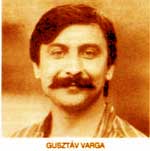

 |
 |

Listen to their music
|
What is the secret of the Kalyi Jag Group's popularity? First of alt their steadfastness and diligence by means of which they collected the Gypsy tunes of their narrower native land Szabolcs-Szatmár county first and then those of wider and wider regions. In the meantime they preserved the valuable elements of their home rendering and developed it to an actable production. The Gypsy listeners of the group can recognize the nicest pieces of their solicitously preserved traditions, the success of the Gypsy traditions in their success thus considering their success as appreciation. The non-Gypsy listeners can admire the many-colouredness, liveliness of the tradition. Presently the members of the group know several hundreds of Gypsy tunes. They should not do anything else but reach into the "drawer" of their memory deeper and deeper to get out the pieces to be treated. On the other hand they miss no opportunity to collect when being abroad or respectively to get acquainted with the traditions of the Gypsies in remote regions through the performances of foreign Gypsy groups. They are engaged in scientific research and regularly visit the archives of the Musicological Institute of the Hungarian Academy of Sciences. The Kalyi Jag Group has formed a peculiar way of rendering, by means of which it can be unmistakably distinguished from the other Gypsy groups. The group is characterized by good vocal endowments and high-level instrument playing and the uniform treatment of the songs. Folklore ensembles aiming not the precise interpretation of folk rendering but the treatment cannot generally resist the "temptation" of the popular music surrounding the contemporary people. The Kalyi Jag also build popular elements in its rendering but they simply colour the euphony and do not prevail over the folk elements. The living Gypsy folk music also manifests certain adaptation to the popular genres and it was also so when the group was formed. The disc primerily offers tunes from Szabolcs-Szatmár county. The other tunes are from different parts of Hungary and further two ones are from abroad. Besides some lyric songs they primarily perform quickly rolled dance tunes. In their accompaniment the oral bass and the spoons and water can substituting for the traditional percussion instruments are elements of great importance. The solistic improvisation of the oral bass not usual in the folk practice is enriched with accompanying words this time (6). Though almost alt the tunes are provided with instrumental accompaniment, two of them sound in entirely traditional form. One of the being a linepaired dance tune of considerably improvisative character-The rolled song of Filtus-is performed as paying their respects to its former singer Mrs János Rostás died long ago (12). On the other hand in the words of the song there are old magic song elements. The other one being a 3/8 stick dance tune (14), which serves as the musical accompaniment of Gypsy stick dances. The words of some songs were written by themselves. These ones are originally the Gypsy variations of Hungarian texts or the completion or respectively recreation of Gypsy texts in similar spirit. The closing song of the disc is a Szatmár arrangement (16), in which the group-leader Gusztáv Varga's birthplace is humorously referred to ("You don't know who I am, I am from Nagyecsed"). At the same time it is the village where the Hungarian Gypsy folk musical movement started off. Katalin Kovalcsik
|
Mi a Kalyi Jag együttes népszerűségének titka? Elsősorban az a kitartás és szorgalom, amellyel összegyűjtötték előbb szűkebb pátriájuk, Szabolcs-Szatmár megye, majd később mind nagyobb területek cigány dallamait. Eközben megőrizték otthonról hozott előadási stílusuk értékes elemeit, és ezt fejlesztették tovább színpadképes produkcióvá. Az együttes cigány hallgatói féltve őrzött hagyományaik legszebb darabjait ismerik föl előadásukban, és sikerükben a cigány hagyományok sikerét, tehát értékként való elismerését látják. A nem cigány hallgatók pedig e hagyomány sokszínűségét, életteliségét csodálják. Az együttes tagjai jelenleg már több száz cigány dallamot ismernek. Nem kellene mást tenniük, mint mind mélyebbre nyúlniuk emlékezetükfiókjába", hogy elővegyék onnan a feldolgozásra szánt darabokat. Ezzel szemben minden lehetőséget megragadnak arra, hogy külföldi útjaikon gyűjtsenek, illetve külföldi cigány együttesek bemutatói alapján megismerjék a távoli vidékek cigányságának hagyományait. Kapcsolatban állnak a tudományos kutatással is, a Magyar Tudományos Akadémia Zenetudományi Intézete archívumának rendszeres látogatói. A Kalyi Jag kialakított egy sajátos előadói stílust, amely félreismerhetetlenül megkülönbözteti őket a többi cigány együttestől. A jó vokális adottságokon kívül fő jellemzőjük a magas színvonalú hangszerjáték és a dalok egységes kidolgozottsága. Az olyan típusú folklóregyüttesek, amelyek nem a népi előadásmód pontos visszaadására, hanem feldolgozásra törekednek, általában nehezen tudnak ellenállni a mai kor emberét körülvevő populáris zenecsábításának". A Kalyi Jag együttes is épít be előadási stílusába populáris elemeket, de ezek csak a hangzást színesítik és nem kerülnek túlsúlyba a népi elemek rovására. Az élő cigány népzene szintén mutat bizonyos alkalmazkodást népszerű műfajokhoz, s ez a vonása már az együttes megalakításának idején is létezett. A hanglemezen elsősorban szabolcs-szatmári dalok szerepelnek, a többi dallam Magyarország más területeiről, további kettő pedig külföldről való. Néhány lassú, lírai dal mellett elsősorban gyorsan pergő táncdallamokat adnak elő. Ezek kíséretének fontos eleme a szájbőgő és a hagyományos ütőhangszerpótló eszközök, a kanál és a vizeskanna. A szájbőgőnek a népi gyakorlatban nem szokásos szolisztikus improvizációját ez alkalommal táncszók bemondásával gazdagították (A/6). Bár csaknem minden dallamot elláttak hangszeres kísérettel, kettő teljesen hagyományos formában szólal meg. Az egyik egy erősen improvizatív jellegű, sorpáros táncdal, melynek címét Filtus pergetője - rég elhunyt, egykori énekese, Rostás Jánosné emléke előtt való tisztelgésként adták (B/4). Ennek a dalnak a szövegében egyébként régi varázslóénekelemek vannak. A másik egy 3/S-os botoló nóta (B/6), amely a cigány botos táncok zenei kíséretéül szolgál. Néhány dalszöveget saját maguk írtak. Ezek az eredetileg magyar nyelvű szövegek cigány változatai vagy cigány szövegek hasonló szellemű kiegészítései, illetve újraalkotásai. Egy szatmári összeállítás zárja a lemezt (B/8), amelyben tréfásan utalnak az együttesvezető, Varga Gusztáv szülőfalujára ("Nem tudjátok, hogy ki vagyok, / Nagyecsedröl való vagyok"). Ez egyben az a falu, ahonnan a magyarországi cigány népzenei mozgalom elindult. Kovalcsik Katalin |